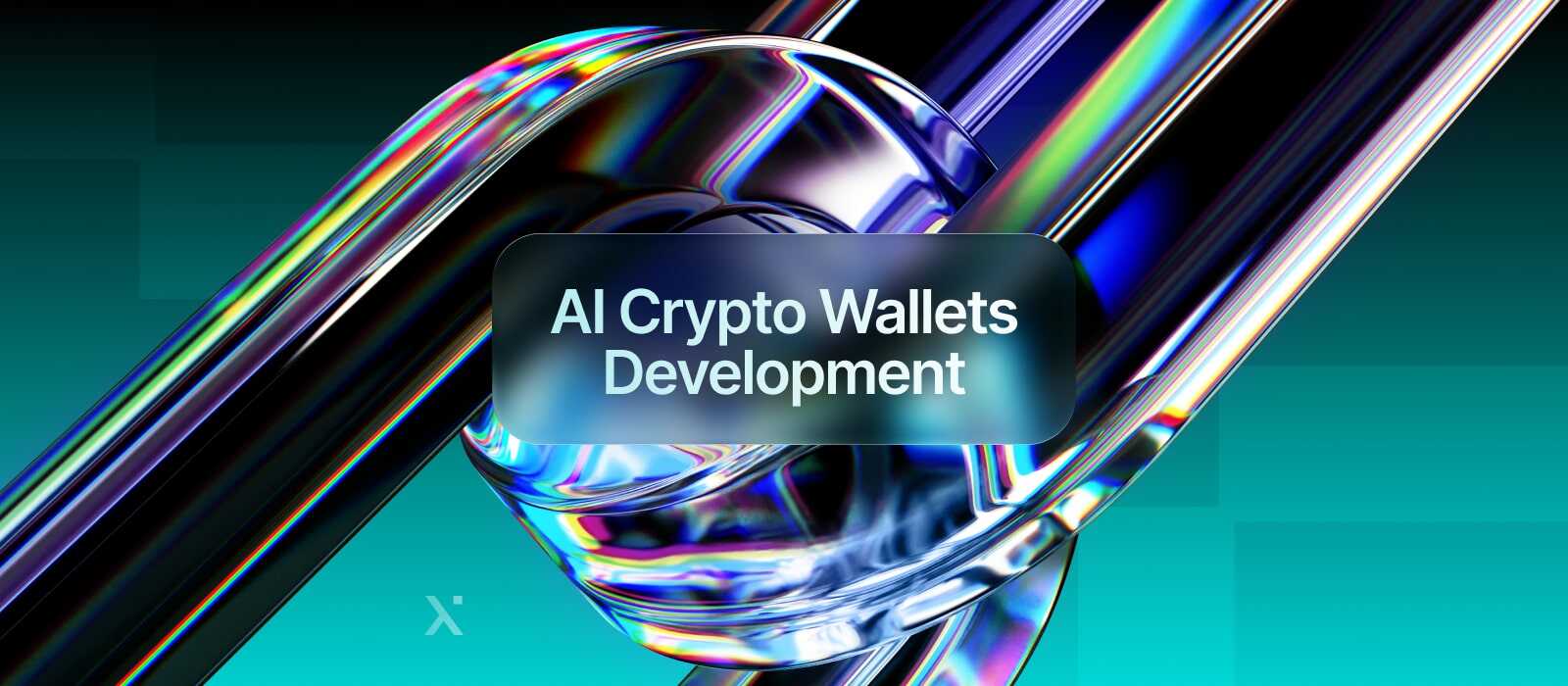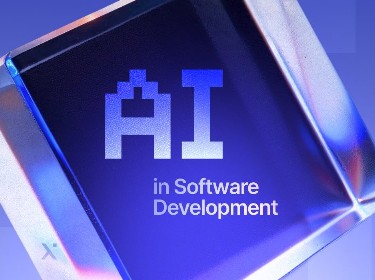What if your wallet became a co-pilot? An intelligent assistant that not only protects your assets but helps you manage them, understand them, and even grow them. This is the new frontier of AI crypto wallet development.
For most people, diving into cryptocurrency at first is complicated. You have private keys, public addresses, gas fees, bridges, swaps, and a fear that because of one wrong click you could lose your hard-earned assets.
This fear isn’t just paranoia, but statistically justified: in 2025, a staggering $2.17 billion in crypto was stolen. In 2024, that number was almost the same – $2.2 billion. This is a fundamental flaw in the user experience, and a huge chunk of this loss – over 40% in many analyses – boils down to one simple, terrifying problem: “private key compromise.”
Your crypto wallet, in its current form, is a “dumb” box. A very secure box, hopefully, but a dumb one. It holds your keys and lets you sign transactions, but that’s about it. It offers no advice, no warning, and no strategy.
What if your wallet became a co-pilot?
This is precisely why the “AI in blockchain” market is exploding, with some analysts projecting a compound annual growth rate of over 23% for the next decade. The industry knows the dumb box isn’t good enough. It’s pouring resources into building an intelligent assistant that not only protects your assets but helps you manage them, understand them, and even grow them, with AI crypto wallet development.
Here at Pixelplex, we’ve been building at the intersection of blockchain and advanced software for years. We’ve seen the good, the bad, and the crazy cool. We’ve written this guide because we believe this shift from a “dumb box” to a “smart co-pilot” is the single most important change coming to the digital asset world. It’s a huge topic, so we’re going deep.
Part 1: A quick look back – the “older” crypto wallets
Before we can appreciate the “smart” wallet, we have to understand the “dumb” one.
The original crypto wallets, like the first Bitcoin clients, were marvels of cryptography. They did one job: generate and protect a “private key,” which is just a very long, secret password. This key is what proves you own your coins. If you lose the key, you lose the crypto. Simple, brutal, and very “crypto.”
| Action | Its function |
| What it stores | It does NOT store coins. It only stores your Private Key (your secret password). |
| Public address | Your shareable “account number” used for receiving funds. It is generated from your private key. |
| Private key | Your secret password is used for sending funds. It proves you are the owner by “signing” transactions. |
| Viewing balance | The wallet scans the public blockchain, finds all transactions for your address, and shows you the total. |
This core function is the foundation of all crypto wallet development services. Over the years, they got prettier. We got mobile wallets, hardware wallets, and browser extensions. They started supporting multiple coins. They added “swap” features.
![]()
But the core problem remained. The user was responsible for everything.
- Want to send ETH? You have to figure out “Gwei” and “gas limits.”
- Want to interact with a new DeFi protocol? You have to read the contract and pray it’s not a scam.
- Worried about security? You have to buy a hardware wallet, store your seed phrase on a steel plate, and bury it in the backyard.
The industry just accepted this, but there were barriers to mass adoption. Normal people don’t want to be their own bank’s high-security vault manager. They just want to send, save, and invest without getting a migraine.
Inside Crypto Wallet MVP Development: Process, Costs, and Real-World Lessons
Canton Network Wallet Development: A Guide on How to Do It Right (and What It'll Cost You)
Part 2: What exactly is an AI crypto wallet?
What happens when you give that “older” wallet a brain? You get an AI wallet.
An AI crypto wallet uses artificial intelligence – specifically technologies like machine learning, predictive analytics, and natural language processing (NLP) – to actively assist the user.
![]()
It’s a fundamental change in philosophy.
- From: “Here are your keys. Good luck.”
- To: “Here are your keys. I’ll watch your back, translate the technical language, and help you find the best path.”
Let’s break down the “AI” part:
- Machine Learning (ML): This is the part that learns – it learns your habits, market patterns, what a “normal” transaction for you looks like. It also learns what a “scam” contract looks like by analyzing thousands of them.
- Predictive analytics: This is the part that guesses – based on what it’s learned, it can predict future gas fees (“Hey, wait 10 minutes, the network will be cheaper”). It can predict market movements (“This token is showing patterns of a ‘rug pull'”).
- Natural Language Processing (NLP): This is the part that talks – it’s the “human” interface. Instead of clicking 15 buttons, you just type: “Send $100 of USDC to mom on the Polygon network.” The AI figures out the rest.
| Component | Function |
| Machine learning (ML) | Learns patterns, habits, and definitions (e.g., scam contracts) from data. |
| Predictive analytics | Guesses future outcomes (e.g., gas fees, market movements) based on learned data. |
| Natural language processing (NLP) | Enables “human” communication and understanding of typed or spoken commands. |
This is the core of modern AI crypto wallet development. It’s not just about adding a chatbot. It’s about weaving intelligence into the entire experience, from security to transactions.
Part 3: What AI wallets can actually do
When you combine these AI technologies, your wallet gets a set of superpowers.
Security that actually secures
Traditional security is reactive. You get hacked, then you find out why. AI security is proactive. It’s a digital guard dog that’s always awake.
![]()
- Proactive threat simulation: Before you even sign a transaction, the AI wallet can run a simulation. It “dry-runs” the smart contract interaction in a safe, sandboxed environment. It then presents a simple, human-readable summary: “If you sign this, you are giving this site permission to spend all your ApeCoin. Are you sure?” This one feature alone could have saved users billions.
- Behavioral biometrics: The AI learns you. Not just your password, but how you type, how you hold your phone, the times of day you’re active. If a transaction comes in at 3 AM from a new location, with a typing pattern that doesn’t match yours… the wallet can trigger extra security, like a video verification. This is a massive leap in data security services.
- Smart contract audit: The AI can scan the smart contract you’re about to use and check it against a massive database of known exploits, scams, and vulnerabilities. It’s like having a security audit and risk management expert looking over your shoulder 24/7.
Your personal crypto economist
An AI wallet acts as your personal economist and data analyst, helping you navigate it.
- Gas fee optimization: This is more than just “low, medium, high.” An AI can analyze the “mempool” and predict with high accuracy what the lowest possible fee will be in the next 30 minutes to get your transaction through.
- Intelligent portfolio management: You can tell your wallet your goals. “I’m a long-term investor with a medium risk tolerance.” The AI can then monitor your portfolio and offer suggestions. “Your holdings are 90% in meme coins, which doesn’t match your stated risk profile. You might consider rebalancing.” It can even connect to advanced business intelligence solutions to give you deep insights.
- Automated tax harvesting: This is a pro-level move. The AI can identify assets in your portfolio that are at a loss, suggest selling them to offset gains you’ve made elsewhere (to reduce your tax bill), and even suggest a similar asset to buy back into.
Blockchain in Payment Services: Trends, Technologies, and Development Best Practices
Centralized Сrypto Exchange Development Explained: From Architecture to Launch
Usability
This might be the biggest win for normal users. AI wallets translate the complexity.
- The intent-centric co-pilot: You don’t perform “swaps” or “bridges.” You just state your intent.
You say: “I want to buy $200 of the new ‘SuperGame’ token.”
The AI does:
- Finds the token.
- Sees it’s on the Base network.
- Sees you only have ETH on the main network.
- Finds the cheapest, safest bridge to move ETH to Base.
- Finds the best-priced DEX on Base to swap that ETH for the token.
- Presents you with a single summary: “This will cost $205.40 (including fees) to get your $200 of SuperGame token. Approve?”
- The chatbot that understands: This is powered by the same tech behind ChatGPT. You can ask it, “What is ‘staking’ and can I do it with my DOT?” The wallet can answer you and guide you through the process. The custom AI chatbot development for these systems is incredibly sophisticated.
This level of natural interaction relies on advanced generative AI integration, turning the wallet from a generic tool into a conversational partner. This is the future of AI crypto wallet development.
Part 4: Challenges and realities of AI wallets
As a team that specializes in complex AI app development, we know the bottlenecks. The road to this future is full of massive, technically difficult challenges.
The unclarity problem
AI, especially deep learning, can be unclear. It can tell you “this transaction is a scam,” but it might struggle to explain why in simple terms. This lack of “explainability” is a problem when you’re dealing with people’s money. Trust requires transparency.
The AI is a target
Hackers won’t just attack the blockchain anymore. They’ll attack the AI. They’ll use “adversarial inputs” to try and trick the AI into approving a bad transaction. The security for the AI model itself has to be ironclad.
Data hunger vs. privacy
To be smart, an AI needs data. A lot of data. Your transaction history, your habits, your portfolio. How do we provide this data without destroying the core crypto concept of privacy and self-sovereignty? This is a huge design challenge. Do we use on-device AI? Federated learning?
Centralization creep
If everyone ends up using a wallet whose “brain” is powered by one or two big tech AI models (like Google’s or OpenAI’s), have we just re-centralized finance in a new, sneakier way? This is a serious philosophical risk.
This isn’t a simple thing, but the journey of AI crypto wallet development is still one of the most difficult (and exciting) challenges in tech today.
You can be sure that as soon as “AI-powered security” is a thing, “AI-powered hacking” will be, too. We’ll see AI-phishing bots that are indistinguishable from humans and AI-powered exploit finders. This means the wallet’s AI can’t be static. It needs constant upgrades, which is why adaptive AI development – AI that can rewrite and improve itself against new threats – is so critical.
Smart Contract Development Cost Demystified: What Every Business Should Know
How to Build a Crypto Wallet: a Complete Guide
Part 5: Building: The process, tech, and tools AI wallet development
How does a team build one of such wallets? The AI crypto wallet development process is a serious feat of engineering.
![]()
The development process
You don’t just “add AI” to a wallet. You have to build the wallet around intelligence.
Strategy & discovery
What’s the goal? Are we building an ultra-secure wallet for pro-traders? Or a super-simple wallet for beginners? The “AI” for each is totally different. The “pro” wallet needs predictive market models. The “beginner” wallet needs a world-class NLP and scam-detection engine.
Core wallet foundation
Before you build the brain, you build the vault. This is the “dumb” part, and it has to be perfect. This step involves all the standard, high-security crypto payment gateway development work: creating the key generation logic, secure storage (like the phone’s keychain or a TEE), and the basic transaction-signing interface.
The AI engine build
This happens in parallel. A separate team of data scientists starts building and training the models. They gather massive datasets (on-chain transaction patterns, known scam contracts, market data) to teach the AI what “safe” and “dangerous” look like.
Secure integration
This is where it all comes together, and it’s the hardest part. The AI needs to talk to the core wallet without ever touching the private keys. The AI’s job is to advise. The wallet’s job is to execute. The connection between them is a one-way street: the AI sends a suggestion (e.g., “HIGH RISK!”), but it can never pull keys or sign a transaction on its own.
Adaptive testing
You can’t just “test” an AI. You have to attack it. This phase involves “red-teaming,” where security experts try to fool the AI. They’ll use adversarial inputs and weird contract types to see if they can get a malicious transaction approved. The AI learns from these attacks and gets stronger.
The tech stack
A true AI crypto wallet is a three-layer cake.
The wallet layer (the interface): This is what you see.
- Mobile: Swift (for iOS) and Kotlin (for Android) for the best performance and access to secure hardware.
- Web/desktop: React or Vue.js for a responsive interface.
- Cross-platform: React Native or Flutter are common choices, but they must be carefully implemented to maintain high security.
The blockchain layer (the “plumbing”): This is how the wallet talks to the outside world.
- Libraries: Web3.js or Ethers.js (for Ethereum and EVM chains), or specific SDKs for chains like Solana or Cosmos.
- Node connection: This requires robust blockchain integration services to get reliable, real-time data. This can mean running your own nodes or using an API service like Infura or Alchemy.
The AI/data layer (the “brain”): This is the new, complex part.
- Language: Python is the undisputed king here, used for virtually all machine learning.
- Core libraries: TensorFlow or PyTorch are the two main frameworks used to build, train, and deploy the machine learning models.
- Security tech: Advanced wallets are using Multi-Party Computation (MPC) to split keys and Trusted Execution Environments (TEEs) to run code in a “black box” that even the server admin can’t see.
| Category | Key technologies | AI/ML components |
| Languages | Python, JavaScript (Node.js), Rust, Go | Python (for ML), TensorFlow, PyTorch |
| Frontend/mobile | React Native, Flutter, React, Kotlin/Swift | In-App AI Assistant, Predictive UI |
| Blockchain interop | Web3.js, Ethers.js, APIs (Alchemy, Infura) | Real-Time Market Data for Predictive Models |
| Smart contracts | Solidity, Move, Vyper | Logic for Automated DeFi/Trading |
| Security/data | Biometrics, AES Encryption, PostgreSQL, Redis | Fraud/Anomaly Detection, Risk Scoring |
To build this, you need a specialized toolbox.
- For AI model training: TensorFlow (from Google) and PyTorch (from Meta) are the industry standards. TensorFlow is often preferred for production environments, while PyTorch is a favorite for rapid research and development.
- For data pipelines: The AI needs data. Tools like Apache Kafka (for streaming real-time transaction data) and Apache Spark (for processing massive historical datasets) are essential. Here professional data analytics services become critical, as cleaning and labeling this data is a massive job.
- For the wallet foundation: Starting with a secure, audited, white label crypto wallet development solution can save months of time and let a team focus its resources on what makes its product unique: the AI layer.
AI MVP Development: How to Validate Ideas Fast Without Breaking the Budget
The Intelligent Bank: Moving Beyond Automation to Strategic AI
Part 6: Real-world examples
Here are several players who are pioneering the “AI crypto wallet” concept. They haven’t solved everything, but they show what’s possible.
![]()
MetaMask (via MetaMask Snaps)
What it does: MetaMask itself isn’t a native AI wallet, but its “Snaps” platform allows third-party developers to add features.
The AI part: Several Snaps (like those from Blockfence or Tenderly) act as AI-powered security. Before you sign a transaction, the Snap simulates it and cross-references the contract with a massive database of known scams. It’s a prime example of the “proactive threat simulation” we discussed earlier.
Fire (browser extension)
What it does: Fire is a simple, brilliant wallet extension that only does one thing: simulate transactions.
The AI part: Before you sign anything, Fire pops up a human-readable window showing you exactly what will happen. “You will receive 150 ‘SuperCoin’. You will lose 1 ETH.” This “simulation” engine is a form of AI (a rule-based system) that prevents the most common scam: the “approve” transaction that actually drains your wallet.
Rabby wallet (by DeBank)
What it does: Rabby is a wallet built from the ground up for DeFi users.
The AI part: Rabby’s key feature is a pre-signing check. It auto-scans the contract you’re about to interact with. It tells you, “This contract has never been used before,” or “This contract has been used in a known phishing attack.” It also automatically selects the right chain for you, so you don’t accidentally try to send a Polygon asset on the Ethereum network. This is a form of classification and risk-scoring AI.
Zerion & Zapper (portfolio managers)
What they do: While not just wallets, these are “portfolio dashboards” that give you an intelligent overview of all your assets.
The AI part: Their “DeFi discovery” and “opportunity” engines use analytics to scan hundreds of protocols and suggest, “You have idle USDC. You could be earning 5% on it in this audited ‘Aave’ pool.” This is a basic personal crypto economist, powered by advanced business intelligence.
These examples show that the AI wallet isn’t one single product. It’s an evolution. It’s a set of intelligent features being added, piece by piece, to make the entire crypto wallet development landscape safer and smarter.
| Solution | Function | AI feature | AI concept |
| MetaMask (via Snaps) | Popular wallet platform | Proactive threat simulation: Simulates transactions against a database | Security & fraud detection |
| Fire (browser extension) | Transaction simulator | Human-readable simulation: Shows the exact outcome (receive/lose) of a transaction | Rule-based AI / smart simulation |
| Rabby Wallet | DeFi-focused wallet | Pre-signing risk check: Auto-scans and classifies contract risk | Classification & risk-scoring AI |
| Zerion & Zapper | Portfolio dashboard | Opportunity/discovery engine: Suggests earning potential | Advanced BI / personal economist |
Part 7: Top AI crypto wallet development companies
The ideas we’ve talked about are massive. They require a special kind of team, and this isn’t a job for your average app shop.
![]()
A handful of companies around the globe are already deep in the trenches, building these next-generation platforms. While this list isn’t exhaustive, it represents some of the key players who have the chops to tackle AI crypto wallet development.
PixelPlex
PixelPlex has been at this since 2007, operating at the sharpest edge where complex finance, AI, and blockchain collide. With 450+ solutions and 3 unicorns under the belt, they are a team of first-principle engineers who build deeply customized, high-performance systems for demanding clients.
Solulab
This team is a true multi-specialist, with a deep bench in blockchain, AI, and the Internet of Things. Solulab has delivered several hundreds of projects, showing they know how to get from idea to launch.
Blockchain App Factory
The name says it all. This company is a vendor for all things token-related IT consulting to the modern tech stack. They combine mature software development processes with new-school expertise in AI, data analytics, and blockchain.
Appinventiv
A major force in the mobile app world, Appinventiv has built a name for creating slick, user-focused applications. They’ve successfully expanded their expertise into blockchain and AI, making them a strong choice for projects that need a high-polish, user-friendly interface.
Antier Solutions
Antier is another veteran in the space, with a sharp focus on the “fin” in “fintech.” They specialize in building crypto exchanges, banking platforms, and, of course, wallets. From crypto and NFTs to full-scale exchange platforms. They are known for their end-to-end service.
LeewayHertz
As one of the early adopters in the blockchain space, LeewayHertz has built a formidable reputation. They’ve worked with some big names, developing enterprise-grade blockchain solutions. Their focus is on building robust, scalable software that large organizations can rely on.
ScienceSoft
ScienceSoft develops AI-integrated crypto wallets with a focus on precision, security, and smart adaptability. Leveraging their deep expertise, they embed AI features like fraud prediction, smart recovery, and tailored interfaces to deliver scalable and highly secure fintech solutions.
Here’s a quick overview of these teams:
| Company | Est. | Focus | Best for… |
| PixelPlex | 2007 | Complex, high-performance Fintech platforms, tokenization | Demanding, custom-built financial systems. |
| Solulab | 2015 | AI & IoT integration | Multi-specialist projects (AI, IoT, blockchain). |
| Blockchain App Factory | 2017 | Tokenization & AI analytics | Full-service token solutions with AI integration. |
| Appinventiv | 2015 | Mobile-first UI/UX | Polished, user-friendly mobile wallet interfaces. |
| Antier Solutions | 2017 | Fintech & exchange platforms | End-to-end fintech (wallets, exchanges, banking). |
| LeewayHertz | 2014 | Enterprise-grade scalability | Robust, scalable software for large organizations. |
| ScienceSoft | 2015 | AI-driven wallet security | High-security wallets (fraud prediction, smart recovery). |
When vetting a potential blockchain vendor, focus on these critical signs:
- A deep, relevant portfolio: Have they actually launched complex projects (like wallets, DeFi protocols, or RWA platforms) that are still in production?
- A security-first mindset: Do they lead the conversation with security audits, risk management, and data protection, or do they treat it as an afterthought?
- Transparent communication: Can their team explain complex technical concepts in plain English and provide a clear, realistic development roadmap?
AI Chatbots in Banking: How The Industry Grows
Custodial vs. Non-Custodial Wallet: Everything You Need To Know
Conclusion
This new kind of wallet doesn’t just store your assets. It understands them. It protects you proactively. It translates mind-numbing complexity into simple, human-intent. And most importantly, it’s ready to manage a whole new universe of on-chain assets.
This is the future. It’s making crypto safer, smarter, and finally, accessible to everyone. The path for AI or MPC wallet development is filled with technical hurdles that require a deeply experienced, multi-disciplinary team.
![]()
And that, frankly, is what we love to do. At PixelPlex, our blockchain development team thrives on these complex challenges. If you’re a company looking to build the next generation of digital asset management, whether it’s a revolutionary AI crypto wallet, a full suite of AI development or crypto services – we’re here for you. We’d be glad to assist and help you map out the journey – just drop us a line here.
FAQ
A normal wallet is just a lockbox. The goal of AI crypto wallet development is to give you a security guard and an assistant, one that spots scams and makes crypto feel less scary.
It is! Instead of you having to be the expert, the AI acts as a co-pilot, simulating transactions before you sign to catch scams. It’s like having a tech-savvy friend looking over your shoulder 24/7.
Absolutely not! The AI’s job is to advise, warn, and simplify. You, and only you, have the final say and the “approve” button on any transaction.
The biggest hurdle is safely connecting the “brain” (the AI) to the “vault” (the private keys). This is why our approach to AI crypto wallet development ensures the AI can never sign transactions, it can only advise.
It’s a huge help! Instead of just guessing, the AI can analyze network traffic and predict the cheapest time in the next 30 minutes to send your transaction
It’s actually better for beginners! The whole point of AI crypto wallet development is to translate the “tech-speak” into simple, human actions. It’s designed to make Web3 finally feel user-friendly.




